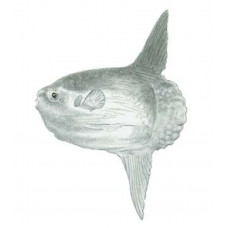Latin name
Mola mola
Other names
Headfish, moonfish; Danish/Swedish: klumpfisk; Dutch: maanvis; Finnish: m hk kala; French: môle commun, poisson-lune; German: mondfisch; Greek: fegaró psaro; Icelandic: tunglfiskur; Italian: pesce luna; Norwegian: månefisk; Polish: samoglów; Portuguese: lua, peixe-lua; Spanish: mola, pez cabeza, pez luna, pez sol; Turkish: pervane.
Identification
The short, strongly laterally compressed body is disk-shaped. Thick skin is covered with small bony tubercles. Dorsal and anal fins high opposed, moved far backward, merged with the reduced caudal fin. Teeth on the jaws merge with each other to form plates, undivided in front. Swim bladder is absent in adults. The oceanic sunfish is characterized by a greatly reduced caudal fin, which is gently curved and robust. It also has long dorsal and anal fins, which it uses to swim by paddling. It has no dorsal and pelvic fins and is a dark brownish gray or gray-blue color. The fish has no scales, a small terminal mouth, and an underdeveloped skeleton.
Distribution
The oceanic sunfish is distributed in temperate and warm waters of the epipelagic World Ocean, in the eastern Pacific Ocean from British Columbia to Peru and Chile. In the western Atlantic Ocean, it is found from Canada to northern South America. In the Southern Hemisphere, this fork reaches the Cape of Good Hope and the coast of Chile. In the far eastern seas, it occurs occasionally in summer in the northern part of the Sea of Japan and near the southern islands of the Great Kuril Ridge.
Habitat
An epipelagic oceanic planktonic form. Often drifting near the surface, lying on their sides, oceanic sunfish may also swim vertically and close to the surface with their dorsal fins protruding above the water. In cold water, they are nimble.
Size
Ocean sunfish can grow up to 10 feet long and 11 feet tall (including dorsal and anal fins) and weigh up to 4,400 pounds. A fish 5.5 meters long has been caught off the Atlantic coast of America.
Life history and Behavior
No information
Food and feeding habits
Oceanic sunfish feed on zooplankton, eel larvae, and small deep-sea fish, as well as jellyfish, crustaceans, mollusks, and brittle stars.
Reproduction
Fertility, up to 300 million eggs. The eggs are pelagic. In the Pacific Ocean, larvae have been recorded between 140°E. - 140°W and 10-30°N, as well as around the Society and Easter Islands, in the Indian Ocean - 10°S, 90°E. Breeding areas are only in the central parts of subtropical circles.
Interesting facts
Ocean sunfish are not good swimmers at all. Other poor swimmers include pufferfish and boxfish. They cannot bend their bodies when they move, so they only swim with the help of their fins. The seahorse does not like to move in vain. It hooks its tail on some aquatic plant and catches its prey. When it rises to the surface, it swims in a spiral - it bends its tail stalk and swims fast and furiously with its dorsal and pectoral fins.
| Classification | |
| Phylum | Chordata |
| Class | Actinopterygii |
| Squad | Tetraodontiformes |
| Family | Molidae |
| Genus | Mola |
| Species | M. mola |
| Features | |
| Conservation status | Vulnerable |
| Habitat | Pelagic |
| Life span, years | No information |
| Maximum body weight, kg | 2300 |
| Maximum length, cm | 330 |
| Sailing speed, m/s | 0.89 |
| Threat to people | Edible |
| Way of eating | Predator |




